Entrepreneurship: Small Business Management, Growth, and Economy
VerifiedAdded on 2024/05/21
|29
|5421
|89
Report
AI Summary
This report provides a detailed analysis of entrepreneurship and small business management, focusing on various entrepreneurial ventures, their scope, and typology. It explores the differences and similarities between ventures, emphasizing their roles, characteristics, and objectives. The report interprets data and statistics to assess the impact of micro and small businesses on the economy, highlighting their importance in social economic growth. It also delves into the characteristics of successful entrepreneurs, their mindset, and the influence of personal backgrounds, while differentiating between entrepreneurship in private and public sectors. The report concludes by evaluating the link between entrepreneurial traits and the impact of personal history on entrepreneurs, contributing to a comprehensive understanding of entrepreneurship and its influence on the economy.

ENTREPRENEURSHIP AND
SMALL BUSINESS
MANAGEMENT
SMALL BUSINESS
MANAGEMENT
Paraphrase This Document
Need a fresh take? Get an instant paraphrase of this document with our AI Paraphraser
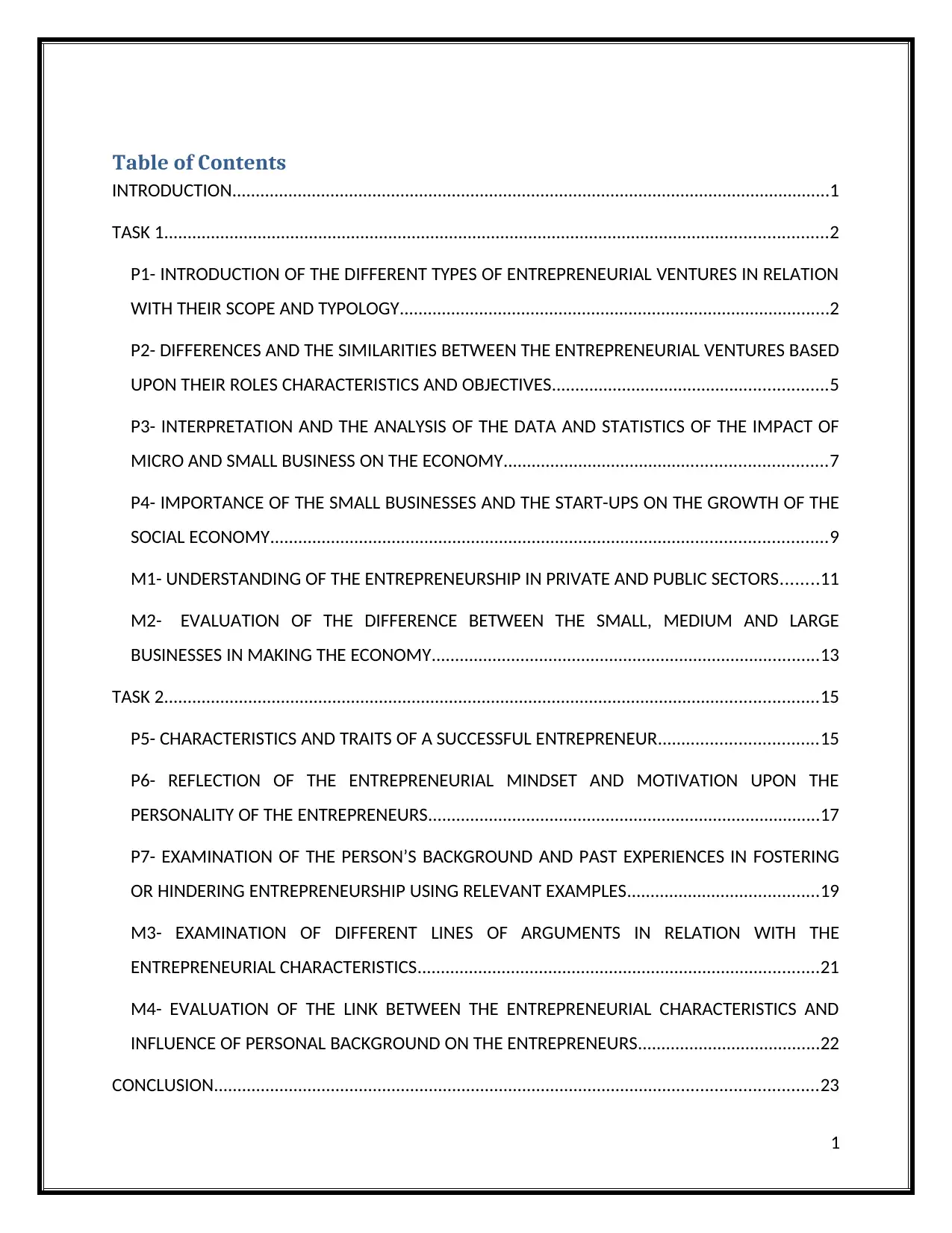
Table of Contents
INTRODUCTION................................................................................................................................1
TASK 1..............................................................................................................................................2
P1- INTRODUCTION OF THE DIFFERENT TYPES OF ENTREPRENEURIAL VENTURES IN RELATION
WITH THEIR SCOPE AND TYPOLOGY............................................................................................2
P2- DIFFERENCES AND THE SIMILARITIES BETWEEN THE ENTREPRENEURIAL VENTURES BASED
UPON THEIR ROLES CHARACTERISTICS AND OBJECTIVES...........................................................5
P3- INTERPRETATION AND THE ANALYSIS OF THE DATA AND STATISTICS OF THE IMPACT OF
MICRO AND SMALL BUSINESS ON THE ECONOMY.....................................................................7
P4- IMPORTANCE OF THE SMALL BUSINESSES AND THE START-UPS ON THE GROWTH OF THE
SOCIAL ECONOMY.......................................................................................................................9
M1- UNDERSTANDING OF THE ENTREPRENEURSHIP IN PRIVATE AND PUBLIC SECTORS........11
M2- EVALUATION OF THE DIFFERENCE BETWEEN THE SMALL, MEDIUM AND LARGE
BUSINESSES IN MAKING THE ECONOMY...................................................................................13
TASK 2............................................................................................................................................15
P5- CHARACTERISTICS AND TRAITS OF A SUCCESSFUL ENTREPRENEUR..................................15
P6- REFLECTION OF THE ENTREPRENEURIAL MINDSET AND MOTIVATION UPON THE
PERSONALITY OF THE ENTREPRENEURS....................................................................................17
P7- EXAMINATION OF THE PERSON’S BACKGROUND AND PAST EXPERIENCES IN FOSTERING
OR HINDERING ENTREPRENEURSHIP USING RELEVANT EXAMPLES.........................................19
M3- EXAMINATION OF DIFFERENT LINES OF ARGUMENTS IN RELATION WITH THE
ENTREPRENEURIAL CHARACTERISTICS......................................................................................21
M4- EVALUATION OF THE LINK BETWEEN THE ENTREPRENEURIAL CHARACTERISTICS AND
INFLUENCE OF PERSONAL BACKGROUND ON THE ENTREPRENEURS.......................................22
CONCLUSION.................................................................................................................................23
1
INTRODUCTION................................................................................................................................1
TASK 1..............................................................................................................................................2
P1- INTRODUCTION OF THE DIFFERENT TYPES OF ENTREPRENEURIAL VENTURES IN RELATION
WITH THEIR SCOPE AND TYPOLOGY............................................................................................2
P2- DIFFERENCES AND THE SIMILARITIES BETWEEN THE ENTREPRENEURIAL VENTURES BASED
UPON THEIR ROLES CHARACTERISTICS AND OBJECTIVES...........................................................5
P3- INTERPRETATION AND THE ANALYSIS OF THE DATA AND STATISTICS OF THE IMPACT OF
MICRO AND SMALL BUSINESS ON THE ECONOMY.....................................................................7
P4- IMPORTANCE OF THE SMALL BUSINESSES AND THE START-UPS ON THE GROWTH OF THE
SOCIAL ECONOMY.......................................................................................................................9
M1- UNDERSTANDING OF THE ENTREPRENEURSHIP IN PRIVATE AND PUBLIC SECTORS........11
M2- EVALUATION OF THE DIFFERENCE BETWEEN THE SMALL, MEDIUM AND LARGE
BUSINESSES IN MAKING THE ECONOMY...................................................................................13
TASK 2............................................................................................................................................15
P5- CHARACTERISTICS AND TRAITS OF A SUCCESSFUL ENTREPRENEUR..................................15
P6- REFLECTION OF THE ENTREPRENEURIAL MINDSET AND MOTIVATION UPON THE
PERSONALITY OF THE ENTREPRENEURS....................................................................................17
P7- EXAMINATION OF THE PERSON’S BACKGROUND AND PAST EXPERIENCES IN FOSTERING
OR HINDERING ENTREPRENEURSHIP USING RELEVANT EXAMPLES.........................................19
M3- EXAMINATION OF DIFFERENT LINES OF ARGUMENTS IN RELATION WITH THE
ENTREPRENEURIAL CHARACTERISTICS......................................................................................21
M4- EVALUATION OF THE LINK BETWEEN THE ENTREPRENEURIAL CHARACTERISTICS AND
INFLUENCE OF PERSONAL BACKGROUND ON THE ENTREPRENEURS.......................................22
CONCLUSION.................................................................................................................................23
1
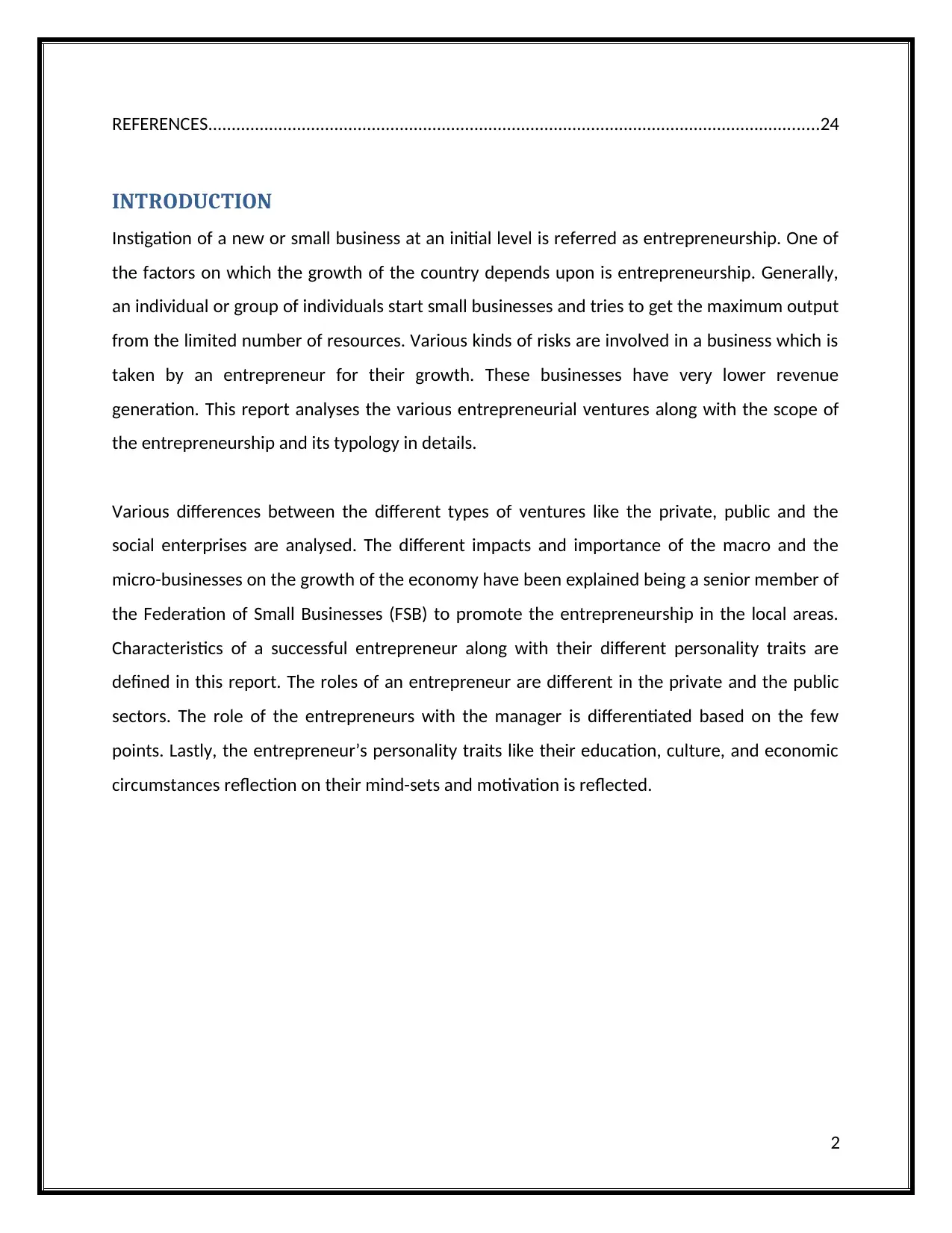
REFERENCES...................................................................................................................................24
INTRODUCTION
Instigation of a new or small business at an initial level is referred as entrepreneurship. One of
the factors on which the growth of the country depends upon is entrepreneurship. Generally,
an individual or group of individuals start small businesses and tries to get the maximum output
from the limited number of resources. Various kinds of risks are involved in a business which is
taken by an entrepreneur for their growth. These businesses have very lower revenue
generation. This report analyses the various entrepreneurial ventures along with the scope of
the entrepreneurship and its typology in details.
Various differences between the different types of ventures like the private, public and the
social enterprises are analysed. The different impacts and importance of the macro and the
micro-businesses on the growth of the economy have been explained being a senior member of
the Federation of Small Businesses (FSB) to promote the entrepreneurship in the local areas.
Characteristics of a successful entrepreneur along with their different personality traits are
defined in this report. The roles of an entrepreneur are different in the private and the public
sectors. The role of the entrepreneurs with the manager is differentiated based on the few
points. Lastly, the entrepreneur’s personality traits like their education, culture, and economic
circumstances reflection on their mind-sets and motivation is reflected.
2
INTRODUCTION
Instigation of a new or small business at an initial level is referred as entrepreneurship. One of
the factors on which the growth of the country depends upon is entrepreneurship. Generally,
an individual or group of individuals start small businesses and tries to get the maximum output
from the limited number of resources. Various kinds of risks are involved in a business which is
taken by an entrepreneur for their growth. These businesses have very lower revenue
generation. This report analyses the various entrepreneurial ventures along with the scope of
the entrepreneurship and its typology in details.
Various differences between the different types of ventures like the private, public and the
social enterprises are analysed. The different impacts and importance of the macro and the
micro-businesses on the growth of the economy have been explained being a senior member of
the Federation of Small Businesses (FSB) to promote the entrepreneurship in the local areas.
Characteristics of a successful entrepreneur along with their different personality traits are
defined in this report. The roles of an entrepreneur are different in the private and the public
sectors. The role of the entrepreneurs with the manager is differentiated based on the few
points. Lastly, the entrepreneur’s personality traits like their education, culture, and economic
circumstances reflection on their mind-sets and motivation is reflected.
2
⊘ This is a preview!⊘
Do you want full access?
Subscribe today to unlock all pages.

Trusted by 1+ million students worldwide
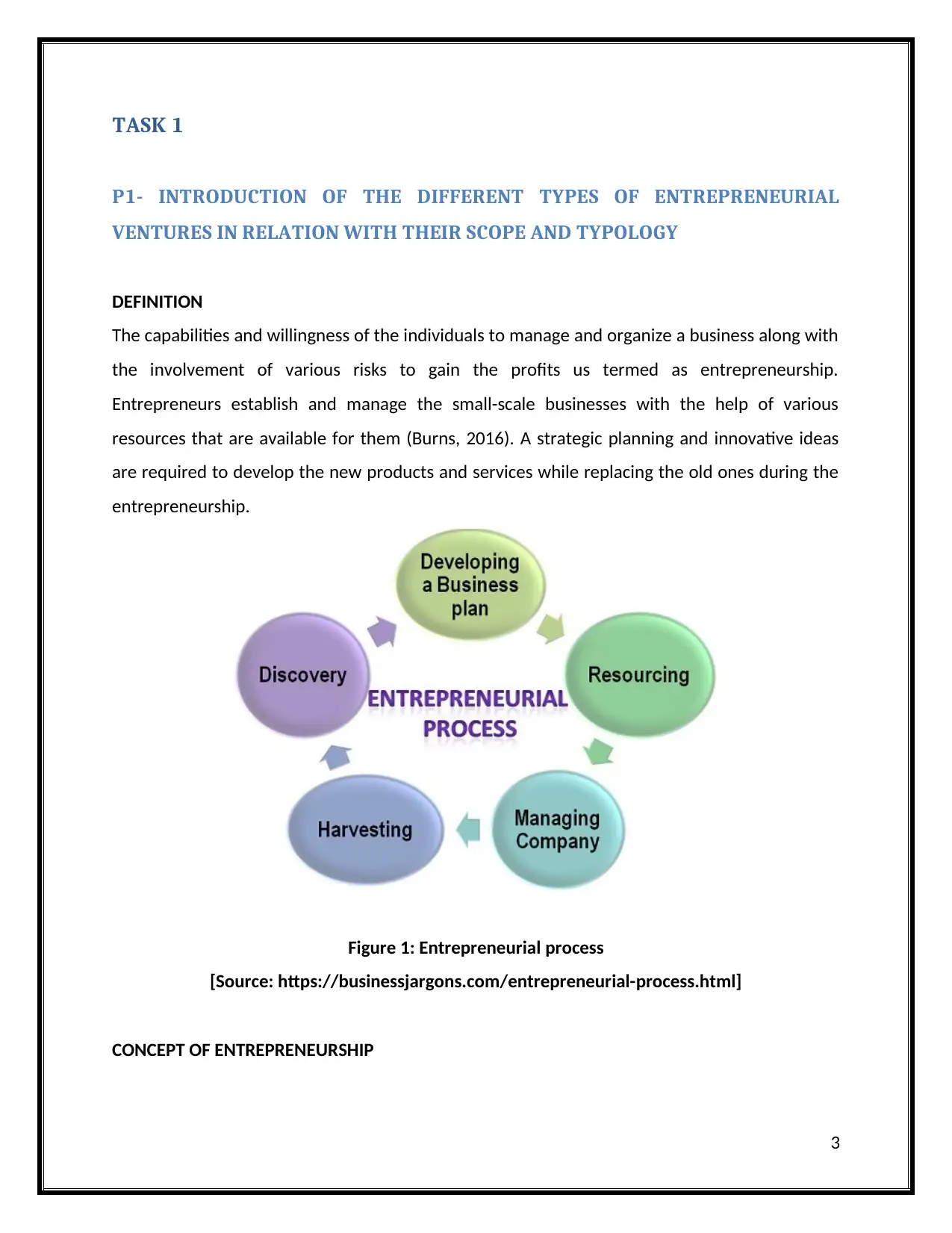
TASK 1
P1- INTRODUCTION OF THE DIFFERENT TYPES OF ENTREPRENEURIAL
VENTURES IN RELATION WITH THEIR SCOPE AND TYPOLOGY
DEFINITION
The capabilities and willingness of the individuals to manage and organize a business along with
the involvement of various risks to gain the profits us termed as entrepreneurship.
Entrepreneurs establish and manage the small-scale businesses with the help of various
resources that are available for them (Burns, 2016). A strategic planning and innovative ideas
are required to develop the new products and services while replacing the old ones during the
entrepreneurship.
Figure 1: Entrepreneurial process
[Source: https://businessjargons.com/entrepreneurial-process.html]
CONCEPT OF ENTREPRENEURSHIP
3
P1- INTRODUCTION OF THE DIFFERENT TYPES OF ENTREPRENEURIAL
VENTURES IN RELATION WITH THEIR SCOPE AND TYPOLOGY
DEFINITION
The capabilities and willingness of the individuals to manage and organize a business along with
the involvement of various risks to gain the profits us termed as entrepreneurship.
Entrepreneurs establish and manage the small-scale businesses with the help of various
resources that are available for them (Burns, 2016). A strategic planning and innovative ideas
are required to develop the new products and services while replacing the old ones during the
entrepreneurship.
Figure 1: Entrepreneurial process
[Source: https://businessjargons.com/entrepreneurial-process.html]
CONCEPT OF ENTREPRENEURSHIP
3
Paraphrase This Document
Need a fresh take? Get an instant paraphrase of this document with our AI Paraphraser

The word undertakes easily describes the entrepreneurship which means taking all the
responsibilities of the business on your own. An entrepreneurship is the ability to take the
setup a business or business enterprise individually and manage it. The entrepreneurs perform
different activities and actions to establish their business enterprises successfully in the market.
DIFFERENT TYPES OF VENTURES AND TYPOLOGY
Different types of the entrepreneurial ventures that can be connected with the company are as
follows-
SMALLER PROFIT VENTURES
The aim of the smaller profit ventures is not to make higher profits but to earn a decent lifestyle
from their business (Parker, 2108). Several small-scale organizations in the UK are smaller profit
ventures like the mom and the pop.
LIFESTYLE VENTURES
The owners of the business with their independencies, autonomy and control on their
businesses are the lifestyle ventures. Lifestyle ventures often run out of their households while
aligning their personal hobbies and interest to attain greater profits in their business. There is
great flexibility in this kind of ventures that can be expanded any time with the help of debt
financing.
SOCIAL ENTREPRENEURSHIP
The entrepreneurs who work only for the social causes of the people and the society are the
social entrepreneurs. Different forms of the social entrepreneurship exist that involves the
tackling with the social problems, improving the lives of the people, tackling the environmental
problems along with the improvement of the communities (Dees, 2017). The main objective of
the social entrepreneurs is to work for the welfare of the society and people.
HIGH GROWTH VENTURES
4
responsibilities of the business on your own. An entrepreneurship is the ability to take the
setup a business or business enterprise individually and manage it. The entrepreneurs perform
different activities and actions to establish their business enterprises successfully in the market.
DIFFERENT TYPES OF VENTURES AND TYPOLOGY
Different types of the entrepreneurial ventures that can be connected with the company are as
follows-
SMALLER PROFIT VENTURES
The aim of the smaller profit ventures is not to make higher profits but to earn a decent lifestyle
from their business (Parker, 2108). Several small-scale organizations in the UK are smaller profit
ventures like the mom and the pop.
LIFESTYLE VENTURES
The owners of the business with their independencies, autonomy and control on their
businesses are the lifestyle ventures. Lifestyle ventures often run out of their households while
aligning their personal hobbies and interest to attain greater profits in their business. There is
great flexibility in this kind of ventures that can be expanded any time with the help of debt
financing.
SOCIAL ENTREPRENEURSHIP
The entrepreneurs who work only for the social causes of the people and the society are the
social entrepreneurs. Different forms of the social entrepreneurship exist that involves the
tackling with the social problems, improving the lives of the people, tackling the environmental
problems along with the improvement of the communities (Dees, 2017). The main objective of
the social entrepreneurs is to work for the welfare of the society and people.
HIGH GROWTH VENTURES
4

Focusing on the various innovations to earn the maximum profits in the business is the main
objective of the high growth ventures. Indefinite growth in the business by pushing their
envelope is the focus of such ventures. In comparison to the lifestyle company, large numbers
of investors are attracted by such ventures. Industrial development is focused on the
companies by the development of the great products and services which also improves the
companies.
5
objective of the high growth ventures. Indefinite growth in the business by pushing their
envelope is the focus of such ventures. In comparison to the lifestyle company, large numbers
of investors are attracted by such ventures. Industrial development is focused on the
companies by the development of the great products and services which also improves the
companies.
5
⊘ This is a preview!⊘
Do you want full access?
Subscribe today to unlock all pages.

Trusted by 1+ million students worldwide
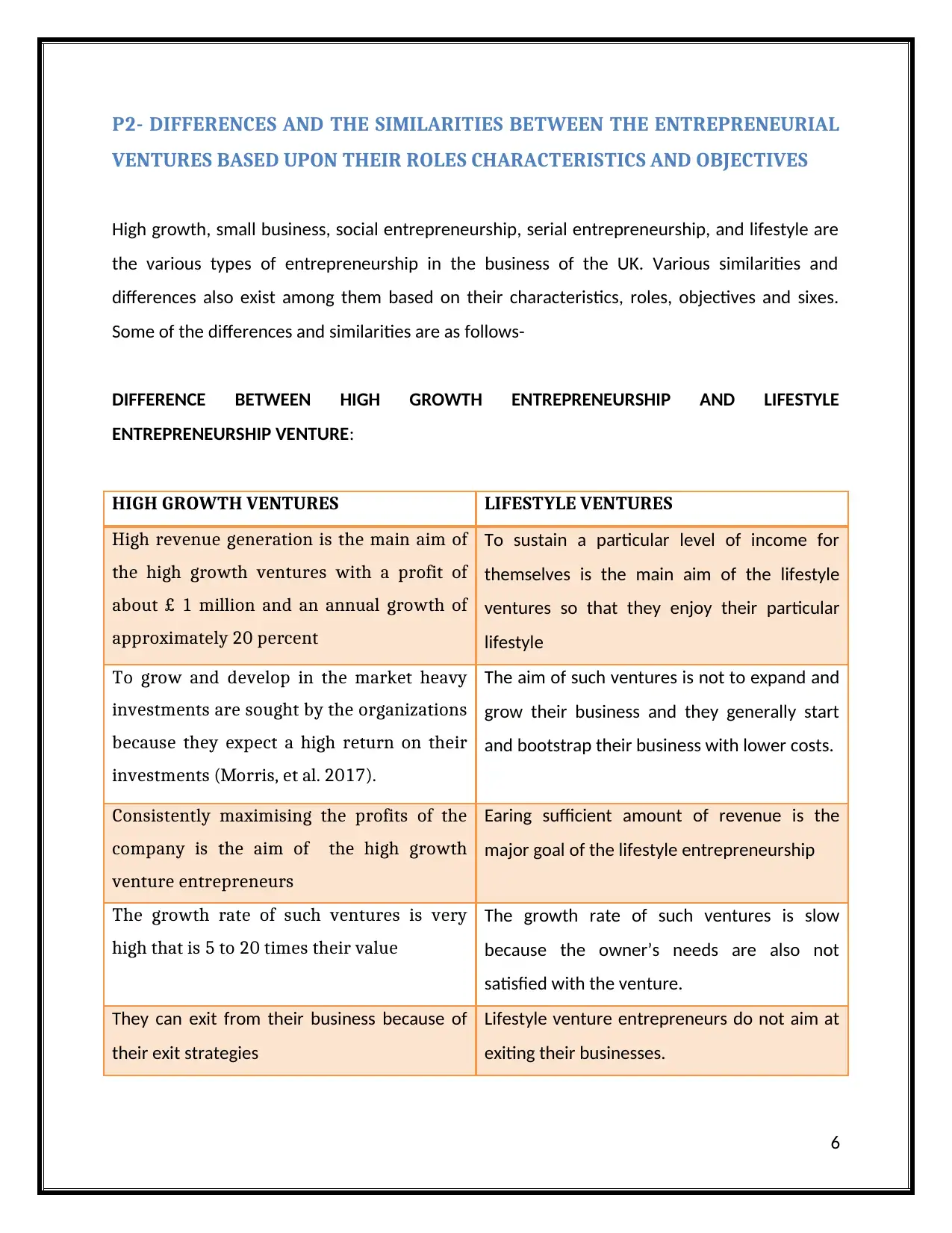
P2- DIFFERENCES AND THE SIMILARITIES BETWEEN THE ENTREPRENEURIAL
VENTURES BASED UPON THEIR ROLES CHARACTERISTICS AND OBJECTIVES
High growth, small business, social entrepreneurship, serial entrepreneurship, and lifestyle are
the various types of entrepreneurship in the business of the UK. Various similarities and
differences also exist among them based on their characteristics, roles, objectives and sixes.
Some of the differences and similarities are as follows-
DIFFERENCE BETWEEN HIGH GROWTH ENTREPRENEURSHIP AND LIFESTYLE
ENTREPRENEURSHIP VENTURE:
HIGH GROWTH VENTURES LIFESTYLE VENTURES
High revenue generation is the main aim of
the high growth ventures with a profit of
about £ 1 million and an annual growth of
approximately 20 percent
To sustain a particular level of income for
themselves is the main aim of the lifestyle
ventures so that they enjoy their particular
lifestyle
To grow and develop in the market heavy
investments are sought by the organizations
because they expect a high return on their
investments (Morris, et al. 2017).
The aim of such ventures is not to expand and
grow their business and they generally start
and bootstrap their business with lower costs.
Consistently maximising the profits of the
company is the aim of the high growth
venture entrepreneurs
Earing sufficient amount of revenue is the
major goal of the lifestyle entrepreneurship
The growth rate of such ventures is very
high that is 5 to 20 times their value
The growth rate of such ventures is slow
because the owner’s needs are also not
satisfied with the venture.
They can exit from their business because of
their exit strategies
Lifestyle venture entrepreneurs do not aim at
exiting their businesses.
6
VENTURES BASED UPON THEIR ROLES CHARACTERISTICS AND OBJECTIVES
High growth, small business, social entrepreneurship, serial entrepreneurship, and lifestyle are
the various types of entrepreneurship in the business of the UK. Various similarities and
differences also exist among them based on their characteristics, roles, objectives and sixes.
Some of the differences and similarities are as follows-
DIFFERENCE BETWEEN HIGH GROWTH ENTREPRENEURSHIP AND LIFESTYLE
ENTREPRENEURSHIP VENTURE:
HIGH GROWTH VENTURES LIFESTYLE VENTURES
High revenue generation is the main aim of
the high growth ventures with a profit of
about £ 1 million and an annual growth of
approximately 20 percent
To sustain a particular level of income for
themselves is the main aim of the lifestyle
ventures so that they enjoy their particular
lifestyle
To grow and develop in the market heavy
investments are sought by the organizations
because they expect a high return on their
investments (Morris, et al. 2017).
The aim of such ventures is not to expand and
grow their business and they generally start
and bootstrap their business with lower costs.
Consistently maximising the profits of the
company is the aim of the high growth
venture entrepreneurs
Earing sufficient amount of revenue is the
major goal of the lifestyle entrepreneurship
The growth rate of such ventures is very
high that is 5 to 20 times their value
The growth rate of such ventures is slow
because the owner’s needs are also not
satisfied with the venture.
They can exit from their business because of
their exit strategies
Lifestyle venture entrepreneurs do not aim at
exiting their businesses.
6
Paraphrase This Document
Need a fresh take? Get an instant paraphrase of this document with our AI Paraphraser

SIMILARITIES BETWEEN THE HIGH GROWTH VENTURES AND LIFESTYLE VENTURES
HIGH GROWTH ENTREPRENEURSHIP
VENTURE
LIFESTYLE ENTREPRENEURSHIP
VENTURE
To increase the productivity of the
employee's great rewards and high benefits
are given to them.
The employees who perform with great
passion are given life rewards and bonuses.
In order to grow and progress in the market,
the high growth ventures aim at earning
higher profits.
In order to survive in the market, the lifestyle
entrepreneurs take various risks to earn
profits for a long duration of time (Welsch,
2017).
Therefore, various similarities and differences exist between the high growth ventures and the
lifestyle ventures based upon the working methods of the entrepreneurs.
7
HIGH GROWTH ENTREPRENEURSHIP
VENTURE
LIFESTYLE ENTREPRENEURSHIP
VENTURE
To increase the productivity of the
employee's great rewards and high benefits
are given to them.
The employees who perform with great
passion are given life rewards and bonuses.
In order to grow and progress in the market,
the high growth ventures aim at earning
higher profits.
In order to survive in the market, the lifestyle
entrepreneurs take various risks to earn
profits for a long duration of time (Welsch,
2017).
Therefore, various similarities and differences exist between the high growth ventures and the
lifestyle ventures based upon the working methods of the entrepreneurs.
7
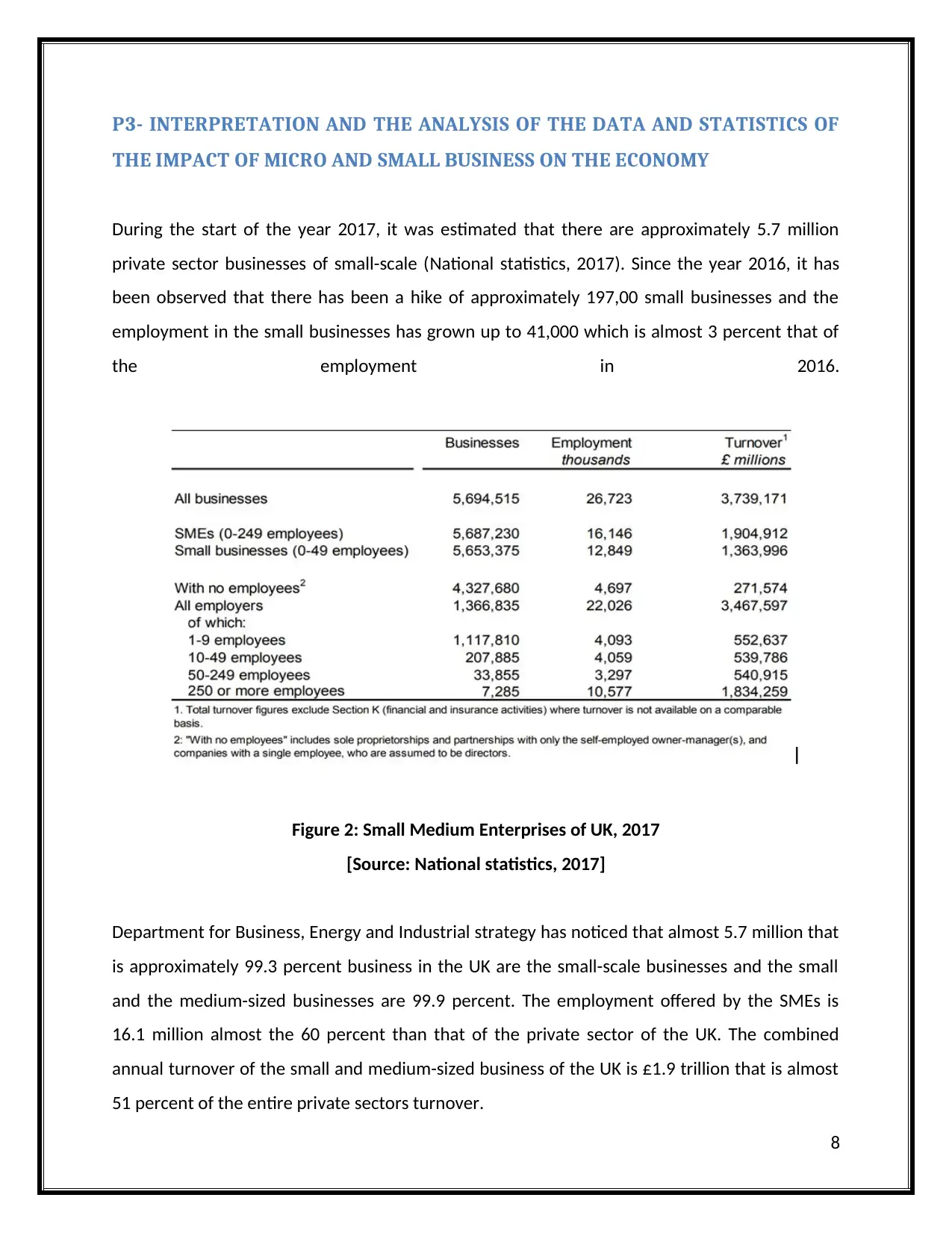
P3- INTERPRETATION AND THE ANALYSIS OF THE DATA AND STATISTICS OF
THE IMPACT OF MICRO AND SMALL BUSINESS ON THE ECONOMY
During the start of the year 2017, it was estimated that there are approximately 5.7 million
private sector businesses of small-scale (National statistics, 2017). Since the year 2016, it has
been observed that there has been a hike of approximately 197,00 small businesses and the
employment in the small businesses has grown up to 41,000 which is almost 3 percent that of
the employment in 2016.
Figure 2: Small Medium Enterprises of UK, 2017
[Source: National statistics, 2017]
Department for Business, Energy and Industrial strategy has noticed that almost 5.7 million that
is approximately 99.3 percent business in the UK are the small-scale businesses and the small
and the medium-sized businesses are 99.9 percent. The employment offered by the SMEs is
16.1 million almost the 60 percent than that of the private sector of the UK. The combined
annual turnover of the small and medium-sized business of the UK is £1.9 trillion that is almost
51 percent of the entire private sectors turnover.
8
THE IMPACT OF MICRO AND SMALL BUSINESS ON THE ECONOMY
During the start of the year 2017, it was estimated that there are approximately 5.7 million
private sector businesses of small-scale (National statistics, 2017). Since the year 2016, it has
been observed that there has been a hike of approximately 197,00 small businesses and the
employment in the small businesses has grown up to 41,000 which is almost 3 percent that of
the employment in 2016.
Figure 2: Small Medium Enterprises of UK, 2017
[Source: National statistics, 2017]
Department for Business, Energy and Industrial strategy has noticed that almost 5.7 million that
is approximately 99.3 percent business in the UK are the small-scale businesses and the small
and the medium-sized businesses are 99.9 percent. The employment offered by the SMEs is
16.1 million almost the 60 percent than that of the private sector of the UK. The combined
annual turnover of the small and medium-sized business of the UK is £1.9 trillion that is almost
51 percent of the entire private sectors turnover.
8
⊘ This is a preview!⊘
Do you want full access?
Subscribe today to unlock all pages.

Trusted by 1+ million students worldwide

The small and the medium-sized enterprises of the UK maintain the economy of the country by
playing a significant role in it. The productivity of the United Kingdom has boosted by
approximately 47 percent by increasing the revenues of the UK, which adds to the economy of
the country that has been observed by the Economic and the Social Research Council (Flynn, et
al. 2015). There is a great need that these businesses must be supported by the investment of
some capital on them so that their businesses can be expanded and economy can be increased.
9
playing a significant role in it. The productivity of the United Kingdom has boosted by
approximately 47 percent by increasing the revenues of the UK, which adds to the economy of
the country that has been observed by the Economic and the Social Research Council (Flynn, et
al. 2015). There is a great need that these businesses must be supported by the investment of
some capital on them so that their businesses can be expanded and economy can be increased.
9
Paraphrase This Document
Need a fresh take? Get an instant paraphrase of this document with our AI Paraphraser
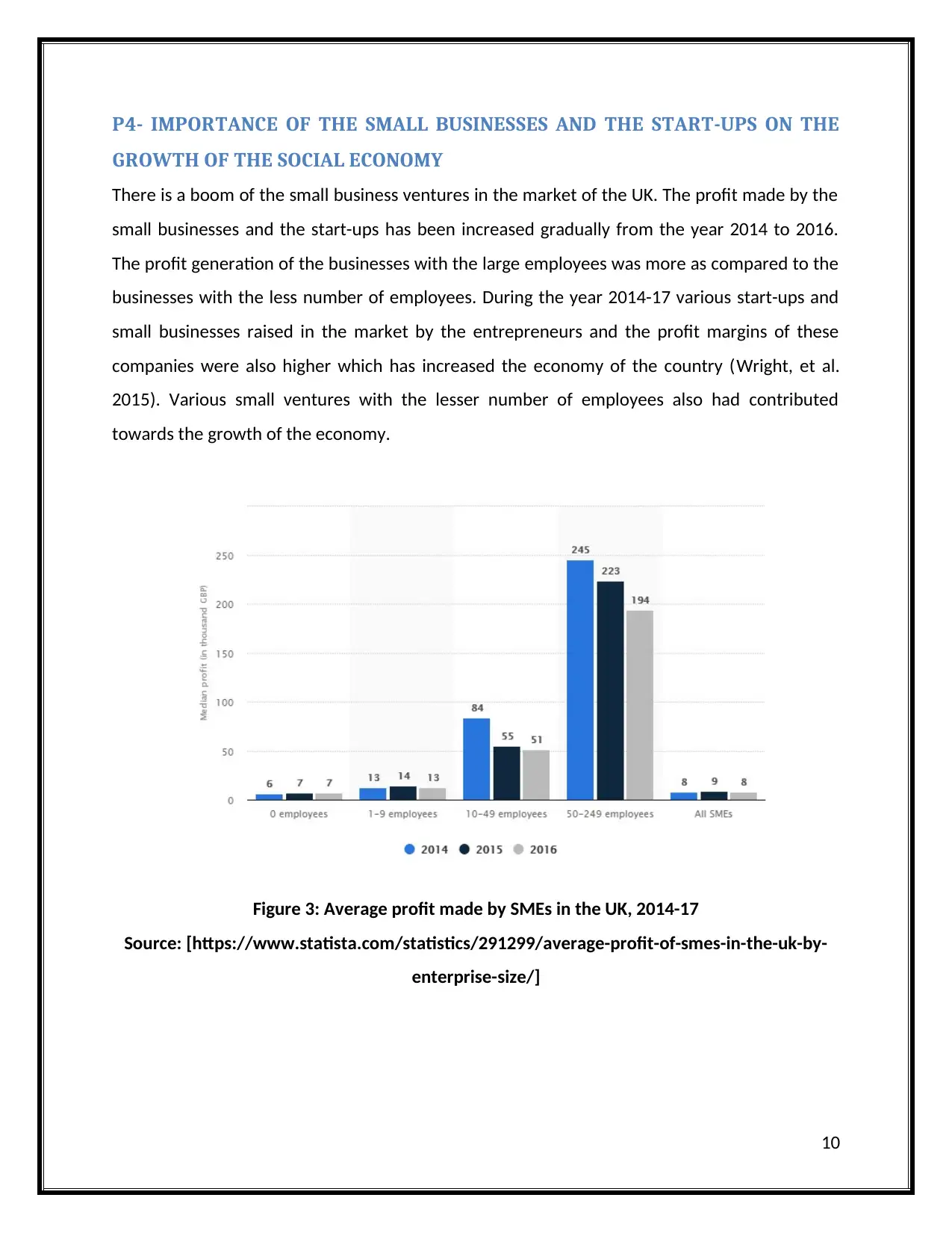
P4- IMPORTANCE OF THE SMALL BUSINESSES AND THE START-UPS ON THE
GROWTH OF THE SOCIAL ECONOMY
There is a boom of the small business ventures in the market of the UK. The profit made by the
small businesses and the start-ups has been increased gradually from the year 2014 to 2016.
The profit generation of the businesses with the large employees was more as compared to the
businesses with the less number of employees. During the year 2014-17 various start-ups and
small businesses raised in the market by the entrepreneurs and the profit margins of these
companies were also higher which has increased the economy of the country (Wright, et al.
2015). Various small ventures with the lesser number of employees also had contributed
towards the growth of the economy.
Figure 3: Average profit made by SMEs in the UK, 2014-17
Source: [https://www.statista.com/statistics/291299/average-profit-of-smes-in-the-uk-by-
enterprise-size/]
10
GROWTH OF THE SOCIAL ECONOMY
There is a boom of the small business ventures in the market of the UK. The profit made by the
small businesses and the start-ups has been increased gradually from the year 2014 to 2016.
The profit generation of the businesses with the large employees was more as compared to the
businesses with the less number of employees. During the year 2014-17 various start-ups and
small businesses raised in the market by the entrepreneurs and the profit margins of these
companies were also higher which has increased the economy of the country (Wright, et al.
2015). Various small ventures with the lesser number of employees also had contributed
towards the growth of the economy.
Figure 3: Average profit made by SMEs in the UK, 2014-17
Source: [https://www.statista.com/statistics/291299/average-profit-of-smes-in-the-uk-by-
enterprise-size/]
10
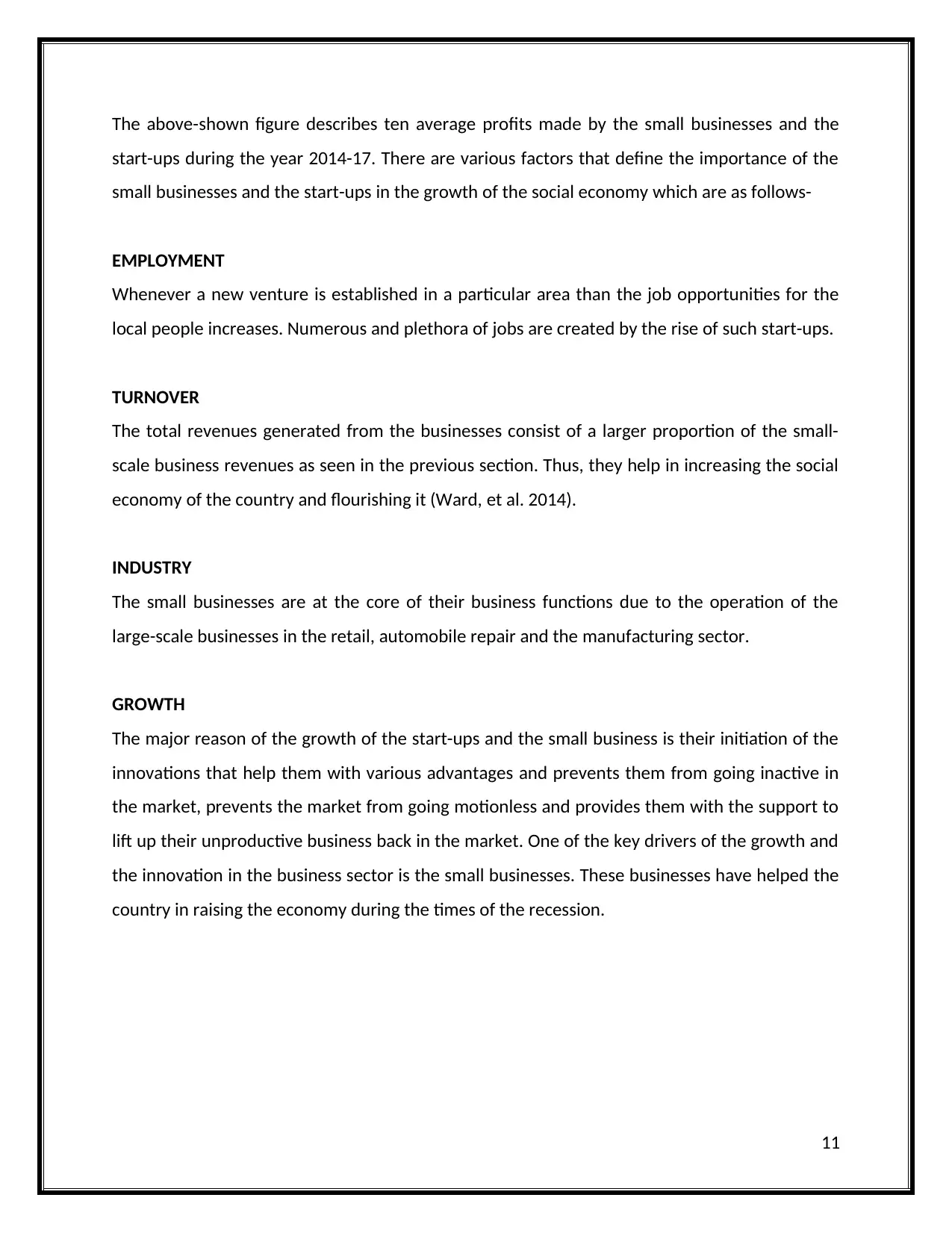
The above-shown figure describes ten average profits made by the small businesses and the
start-ups during the year 2014-17. There are various factors that define the importance of the
small businesses and the start-ups in the growth of the social economy which are as follows-
EMPLOYMENT
Whenever a new venture is established in a particular area than the job opportunities for the
local people increases. Numerous and plethora of jobs are created by the rise of such start-ups.
TURNOVER
The total revenues generated from the businesses consist of a larger proportion of the small-
scale business revenues as seen in the previous section. Thus, they help in increasing the social
economy of the country and flourishing it (Ward, et al. 2014).
INDUSTRY
The small businesses are at the core of their business functions due to the operation of the
large-scale businesses in the retail, automobile repair and the manufacturing sector.
GROWTH
The major reason of the growth of the start-ups and the small business is their initiation of the
innovations that help them with various advantages and prevents them from going inactive in
the market, prevents the market from going motionless and provides them with the support to
lift up their unproductive business back in the market. One of the key drivers of the growth and
the innovation in the business sector is the small businesses. These businesses have helped the
country in raising the economy during the times of the recession.
11
start-ups during the year 2014-17. There are various factors that define the importance of the
small businesses and the start-ups in the growth of the social economy which are as follows-
EMPLOYMENT
Whenever a new venture is established in a particular area than the job opportunities for the
local people increases. Numerous and plethora of jobs are created by the rise of such start-ups.
TURNOVER
The total revenues generated from the businesses consist of a larger proportion of the small-
scale business revenues as seen in the previous section. Thus, they help in increasing the social
economy of the country and flourishing it (Ward, et al. 2014).
INDUSTRY
The small businesses are at the core of their business functions due to the operation of the
large-scale businesses in the retail, automobile repair and the manufacturing sector.
GROWTH
The major reason of the growth of the start-ups and the small business is their initiation of the
innovations that help them with various advantages and prevents them from going inactive in
the market, prevents the market from going motionless and provides them with the support to
lift up their unproductive business back in the market. One of the key drivers of the growth and
the innovation in the business sector is the small businesses. These businesses have helped the
country in raising the economy during the times of the recession.
11
⊘ This is a preview!⊘
Do you want full access?
Subscribe today to unlock all pages.

Trusted by 1+ million students worldwide
1 out of 29
Related Documents
Your All-in-One AI-Powered Toolkit for Academic Success.
+13062052269
info@desklib.com
Available 24*7 on WhatsApp / Email
![[object Object]](/_next/static/media/star-bottom.7253800d.svg)
Unlock your academic potential
Copyright © 2020–2025 A2Z Services. All Rights Reserved. Developed and managed by ZUCOL.




